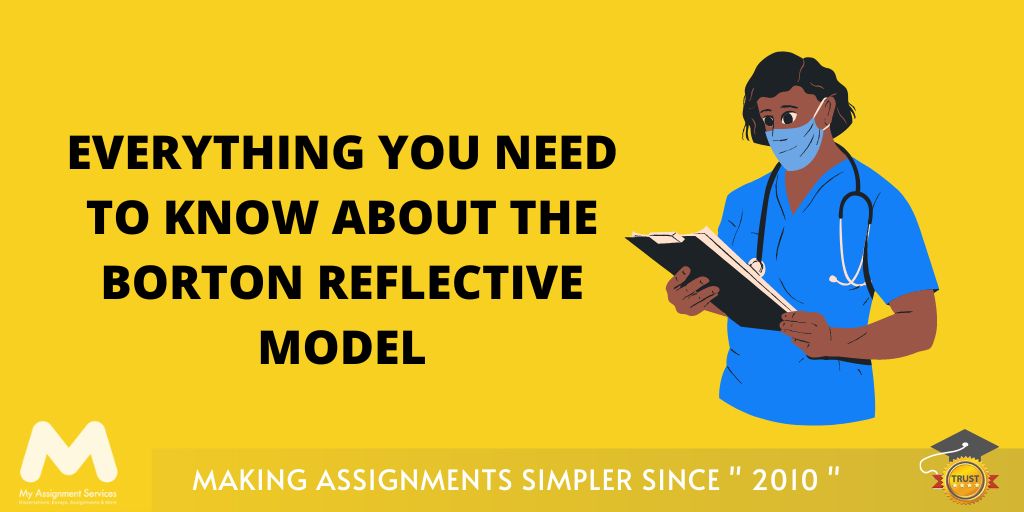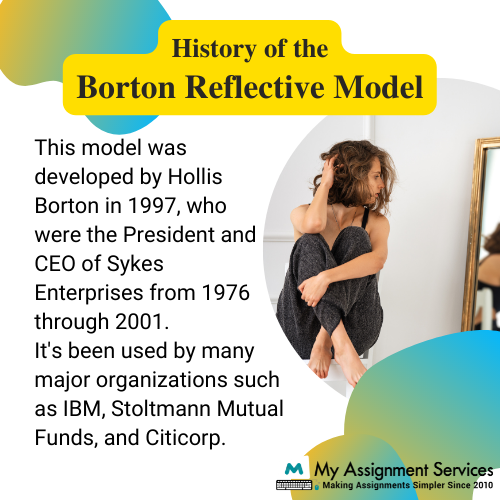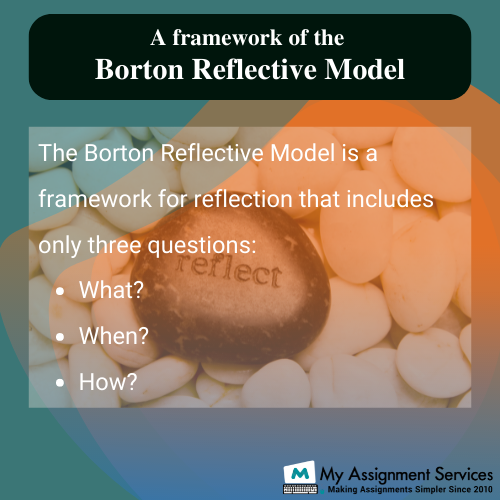
When you ask someone to make an introductory speech, they'll often talk about themselves and how they're going to talk. But what if there's no one around to introduce you? Which model do you use? The reflective model, or the Borton Model.
The Borton Reflective Model is a type of reflective model used by the United States Department of Justice (DOJ) to create sentencing guidelines for federal cases. The model was created in 1962 as a legal response to growing racial tension in the United States. It was designed to provide more equality among people when assigning sentencing decisions.

The Borton Reflective Model, developed by Dr. Martin J. Borton, has come to be known as an industry-standard in successful conflict management. The Borton Reflective Model describes the physical and behavioural characteristics of an effective negotiator, who can establish a cooperative stance between opposites without compromising their own goals and position in the process. The Borton Reflective Model can be useful for developing cooperative attitudes through observation of the behaviours of those around us.
The Borton Reflective Model is a framework of design thinking that was developed by Don Norman in the 1990s. It's intended to help people who work in teams and make decisions together be more effective, productive, and creative.
Norman studied how people think and why they do what they do. He found that there are three different types of thinking: cognitive, emotional, and reflective. Cognitive thinking is about problem-solving; emotional thinking is about feelings, and reflective thinking is about understanding your emotions when you're doing something.
The Borton Reflective Model tries to improve all three of these types of thinking by encouraging people to ask questions that help them understand each type better and use their intuition before making decisions.
The Borton Reflective Model is a framework that helps people understand how the brain processes information and the way they can use this information to make better decisions.
The brain has three levels of processing: sensory, motor, and cognitive. At the sensory level, information from your environment is received through your eyes and other senses. At the motor level, your muscles move so you can send messages to your brain about what you see and hear. At the cognitive level, which is where most of your thinking happens, you think about what you've seen or heard and combine it with other pieces of information to come up with an opinion or decision on something.
These three levels of processing are linked to each other in many ways - for example, how well you can see shapes is linked to how well you recognize them as shapes; how well you can move your body is linked to how well your brain can recognize certain objects as being different from others; etc.
Borton's model is built around three key concepts:

The Borton Reflective Model is a framework for reflection that includes only three questions:
Let's have a brief overview of all the questions.
This part of the reflection process describes what exactly happened about an event, task, or experience. You briefly describe what happened and what you and others did. You can use this part to describe people, places, things, and events. You might also include thoughts, feelings, or emotions you had during the event.
What part of reflection is often the most difficult one to write? It can be hard to recall all the details that happened, especially if they are not important to your learning. You may also find it challenging to describe your thoughts and feelings without getting too emotional or sharing too much information about someone else's personal life.
This part of the reflection process describes when something happened or when you did something. It also includes when people witnessed things and how they reacted. The when part of reflection is often the easiest to write. You can just write down the date and time, or you can use other details to describe what happened at that moment.
For example, if you were working on an assignment and wanted to know when you should start it, you could write down the date and time when you decided to do so. You could also describe what was going on around you during that period.
This part of the reflection process describes how things were set up so that a certain outcome could happen, for example by describing how individuals reacted to each other's behaviour and their behaviour as well as how their interactions affected one another over time.
This part of the reflection process describes how things were set up so that a certain outcome could happen, for example by describing how individuals reacted to each other's behaviour and their behaviour as well as how their interactions affected one another over time. It is important to note that this reflection can be used to support your theory of change by explaining how the behaviours you are modelling have changed over time and how this demonstrates a shift in the way people interact with one another.
For example, if you are working with a team that has been experiencing conflict and frustration due to communication breakdowns, you may reflect on how people are interacting with one another differently now than they did before. You might describe how individuals used to be more reactive and emotional when responding to each other's comments but have become more thoughtful and considerate of other's needs as they listen more carefully.
It seems like there are an endless number of different models and theories out there on the topic of leadership development, but most fail to respond to the problems that plague business and higher education alike. Borton's Reflective model is different. It was created to serve as a guide for leaders in their personal development and thus addresses the key problem areas as well. In essence, Borton has created a model to help leaders become better leaders, one in which they can continue to grow as time goes on.
Many scholars get stuck with their nursing assignments that include concepts like the Borton reflective model. In such a case, they seek nursing assignment help to solve their answers in the best quality with the support from experts. My Assignment Services is a leading academic assistance provider in Canada that facilitates students with 24*7 nursing assignment help. The experts at My Assignment Services have comprehensive knowledge about nursing assignments and have been assisting students in submitting pristine assignments. Contact us by filling out the form and they will be ready to assist you with your Borton reflection model assignments.

Keith Morris is a certified nurse who retired as a registered nurse after participating in a WHO campaign in Geneva. He is dedicated to helping students score good grades in their nursing courses and are offered a chance to help the people and establish a better healthcare community across the globe. He works as a nurse at a local clinic with underprivileged children and provides assignment guidance to the students. Reflection writing, aged care, Gibbs reflective cycle, cardiac nursing, pathophysiology, etc. are a few to name from his area of dominance.
1,212,718Orders
4.9/5Rating
5,063Experts
Turnitin Report
$10.00Proofreading and Editing
$9.00Per PageConsultation with Expert
$35.00Per HourLive Session 1-on-1
$40.00Per 30 min.Quality Check
$25.00Total
FreeGet
500 Words Free
on your assignment today
Get
500 Words Free
on your assignment today
Trending now
The Student Corner
Subscribe to get updates, offers and assignment tips right in your inbox.
Popular Posts
Popular Posts
Doing your Assignment with our samples is simple, take Expert assistance to ensure HD Grades. Here you Go....
Speak directly with a qualified subject expert.
Get clarity on your assignment, structure, and next steps.
In this free session, you can:
Loved reading this Blog? Share your valuable thoughts in the comment section.
Add comment